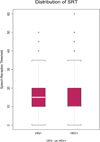Speech audiometry findings from HIV+ and HIV- adults in the MACS and WIHS longitudinal cohort studies
- PMID: 27477593
- PMCID: PMC5125885
- DOI: 10.1016/j.jcomdis.2016.07.004
Speech audiometry findings from HIV+ and HIV- adults in the MACS and WIHS longitudinal cohort studies
Abstract
The purpose of this study was to compare various speech audiometry measures between HIV+ and HIV- adults and to further evaluate the association between speech audiometry and HIV disease variables in HIV+ adults only. Three hundred ninety-six adults from the Multicenter AIDS Cohort Study (MACS) and Women's Interagency HIV Study (WIHS) completed speech audiometry testing. There were 262 men, of whom 117 (44.7%) were HIV+, and 134 women, of whom 105 (78.4%) were HIV+. Speech audiometry was conducted as part of the standard clinical audiological evaluation that included otoscopy, tympanometry, and pure-tone air- and bone-conduction thresholds. Specific speech audiometry measures included speech recognition thresholds (SRT) and word recognition scores in quiet presented at 40dB sensation level (SL) in reference to the SRT. SRT data were categorized in 5-dB steps from 0 to 25dB hearing level (HL) with one category as ≥30dB HL while word recognition scores were categorized as <90%, 90-99%, and 100%. A generalized estimating equations model was used to evaluate the association between HIV status and both ordinal outcomes. The SRT distributions across HIV+ and HIV- adults were similar. HIV+ and HIV- adults had a similar percentages of word recognition scores <90%, a lower percentage of HIV- adults had 90-99%, but HIV- adults had a higher percentage of 100%. After adjusting for covariables, HIV+ adults were borderline significantly more likely to have a higher SRT than HIV- adults (odds ratio [OR]=1.45, p=0.06). Among HIV+ adults, HIV-related variables (i.e., CD4+ T-cell counts, HIV viral load, and ever history of clinical AIDS) were not significantly associated with either SRT or word recognition score data. There was, however, a ceiling effect for word recognition scores, probably the result of obtaining this measure in quiet with a relatively high presentation level. A more complex listening task, such as speech-in-noise testing, may be a more clinically informative test to evaluate the effects of HIV on speech communication.
Keywords: Adults; HIV; Speech audiometry.
Copyright © 2016 Elsevier Inc. All rights reserved.
Figures



Similar articles
-
Speech in Noise Perception as a Marker of Cognitive Impairment in HIV Infection.Ear Hear. 2018 May/Jun;39(3):548-554. doi: 10.1097/AUD.0000000000000508. Ear Hear. 2018. PMID: 29112532 Free PMC article.
-
Effects of SoundBite Bone Conduction Hearing Aids on Speech Recognition and Quality of Life in Patients with Single-Sided Deafness.Neural Plast. 2020 Sep 8;2020:4106949. doi: 10.1155/2020/4106949. eCollection 2020. Neural Plast. 2020. PMID: 32963516 Free PMC article.
-
Clinical experience with the words-in-noise test on 3430 veterans: comparisons with pure-tone thresholds and word recognition in quiet.J Am Acad Audiol. 2011 Jul-Aug;22(7):405-23. doi: 10.3766/jaaa.22.7.3. J Am Acad Audiol. 2011. PMID: 21993048
-
Speech audiometry in noise-exposed workers: the SRT-PTA relationship revisited.Audiology. 1999 Jan-Feb;38(1):30-43. doi: 10.3109/00206099909073000. Audiology. 1999. PMID: 10052834 Review.
-
Implantable Devices for Single-Sided Deafness and Conductive or Mixed Hearing Loss: A Health Technology Assessment.Ont Health Technol Assess Ser. 2020 Mar 6;20(1):1-165. eCollection 2020. Ont Health Technol Assess Ser. 2020. PMID: 32194878 Free PMC article.
Cited by
-
Speech in Noise Perception as a Marker of Cognitive Impairment in HIV Infection.Ear Hear. 2018 May/Jun;39(3):548-554. doi: 10.1097/AUD.0000000000000508. Ear Hear. 2018. PMID: 29112532 Free PMC article.
-
Words-in-Noise Test Performance in Young Adults Perinatally HIV Infected and Exposed, Uninfected.Am J Audiol. 2020 Mar 5;29(1):68-78. doi: 10.1044/2019_AJA-19-00042. Epub 2020 Jan 31. Am J Audiol. 2020. PMID: 32004075 Free PMC article.
-
Main Aspects of Peripheral and Central Hearing System Involvement in Unexplained HIV-Related Hearing Complaints.Front Neurol. 2019 Aug 6;10:845. doi: 10.3389/fneur.2019.00845. eCollection 2019. Front Neurol. 2019. PMID: 31447765 Free PMC article. Review.
References
-
- Barkan SE, Melnick SL, Preston-Martin S, Weber K, Kalish LA, Miotti P, et al. The Women's Interagency HIV Study. WIHS Collaborative Study Group. Epidemiology. 1998;9(2):117–125. - PubMed
-
- Centers for Disease Control and Prevention. 2014 Retrieved from: https://www.cdc.gov/mmwr/preview/mmwrhtml/00018871.htm.
-
- DHHS/Henry J. Kaiser Family Foundation Panel on Clinical Practices for the Treatment of HIV Infection. Guidelines for the use of antiretroviral agents in HIV-infected adults and adolescents. 2008 - PubMed
Publication types
MeSH terms
Grants and funding
LinkOut - more resources
Full Text Sources
Other Literature Sources
Medical
Research Materials
Miscellaneous

